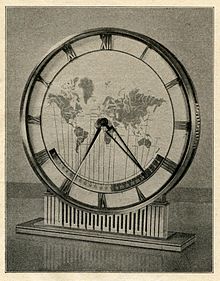Heinrich Johannes Möller
Heinrich Johannes Möller (born April 21, 1905 in Wiesbaden ; † February 21, 1983 in Villingen-Schwenningen ) was a German watch designer, primarily for the Kienzle company .
Life
Möller learned the carpentry trade from Heinrich Roth in Lauterbach (Hesse) from 1920 to 1922 . He successfully passed the journeyman's examination on May 5, 1923. After a further three years of professional experience, he attended the carpentry school in Blankenburg (Harz) from November 1926 to April 1927 . This private school prepared professional practitioners for managerial tasks in a (wood processing) company. In addition to specialist courses in design and drawing, Möller also attended commercial courses in accounting and costing.
Then the Deutsche Uhrenfabrik A.-G. (DUFA) in Mühlhausen / Thuringia offered the 22-year-old as a designer. There he was responsible for the design of modern housing and for the conception of the exhibition rooms. During the global economic crisis at the end of the 1920s, DUFA, like many other watch companies, got into serious problems. In 1931, the Kienzle watch factories in Schwenningen took over the production of DUFA watches.
When the two companies merged, Heinrich Möller was appointed head of the architecture and design office of Kienzle. Möller designed clocks, was responsible for the overall conception of the collection and also for the interior design of the presentation rooms and exhibition stands. In 1937 Kienzle granted him power of attorney and in 1949 the power of attorney.
After 39 years with the company at Kienzle, Möller retired in 1970. He died on February 21, 1983 and was buried in the Bad Dürrheim cemetery.
Working at Kienzle
When Heinrich Möller came to Kienzle in 1931, he met a company on the move. Kienzle tried to position itself as a quality brand compared to other competitors and intensified its focus on good design, high-quality materials and solid workmanship. In 1932 the company received half of all prizes in the design competition organized by the Society for Time Measurement and Watch Technology.
From 1935, the focus was increasingly on design elements. One of the typical Kienzle elements of this time was the factual design of the clocks, which largely managed without ornaments. The dials had characteristic, mostly rather small numbers in a few standard fonts. The Triennale in Milan in 1940 honored the designs of the Möller design office with a gold medal. In 1942 Kienzle was represented in the exhibition “Shapely consumer goods for export”.
In 1939 Heinrich Möller designed a world clock as an official gift from the Wuerttemberg district on the 50th birthday of Adolf Hitler. It was equipped with a massive base and a meander made of swastikas and showed Germany as the center of the world. After a redesign in a slightly modified form, the watch turned out to be a long-runner of the company, which could be bought from 1956 until the company's bankruptcy in 1996.
After the Second World War, the Kienzle watches lost their role in shaping style and followed current (international) style tendencies, be it neoclassicism, " Gelsenkirchen Baroque ", the organic forms of the 1950s and the more sober " international style " of the 1960s. In 1954 Kienzle was represented in the exhibition " Gute Industrieform ". The special shows at the Hanover Fair from 1962 to 1964 showed Kienzle watches as well as the 1963 “Zentrum Form” of the Baden-Württemberg State Trade Office and the 1964 Milan Triennale.
meaning
Unlike Max Bill or Richard Sapper , for example , Möller was not an artist or freelance designer commissioned by watch factories or companies for high-quality living space. Möller began his work when the academic career profile of the designer was just emerging. He himself had completed a craft training with additional qualifications in furniture design and industrial production. Möller was on the threshold of an epoch. In his professional understanding, Möller was still a traditionally employed draftsman with business knowledge, but his watch designs were the first to show a modern design concept.
literature
- Johannes Graf: With period clocks from the global economic crisis. The designer Heinrich Möller and the Kienzle watch factories. In: German Society for Chronometry. Annual journal, Vol. 53, 2014, pp. 53–80.
Web links
| personal data | |
|---|---|
| SURNAME | Möller, Heinrich Johannes |
| ALTERNATIVE NAMES | Möller, Heinrich |
| BRIEF DESCRIPTION | German watch designer |
| DATE OF BIRTH | April 21, 1905 |
| PLACE OF BIRTH | Wiesbaden |
| DATE OF DEATH | February 21, 1983 |
| Place of death | Villingen-Schwenningen |

